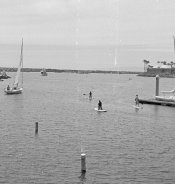Man, it seems I'm having the worst luck. My kids asked me to teach them about film photography and developing. So I broke out all my old gear got some new chemistry and started teaching. Now both of my kids have successfully developed their own films (and made a few mistakes also). Every roll of my own I've messed up in one way or another. This latest error I am perplexed by is these kind of wavy railroad tracks down the middle of the whole roll.
Now this is my first time developing with the Patterson tank with twirling agitation instead of my 15 year old jobo which I was doing inversions with. But I just don't see how the spinning agitation can account for these marks. The Patterson reels did seem easier to load at first but then became more difficult in the last 8-10 frames of the roll of 36.
I've attached a 100% crop of one of the frames. This was TMax 400 developed in D76 for 10:15, followed by normal stop, fix, hypo, wash, photoflo. I used the spinning agitation according the cues from the Massive Dev Chart app. There are 2 or 3 frames near the end of the roll that also have some liquid marks.
Now this is my first time developing with the Patterson tank with twirling agitation instead of my 15 year old jobo which I was doing inversions with. But I just don't see how the spinning agitation can account for these marks. The Patterson reels did seem easier to load at first but then became more difficult in the last 8-10 frames of the roll of 36.
I've attached a 100% crop of one of the frames. This was TMax 400 developed in D76 for 10:15, followed by normal stop, fix, hypo, wash, photoflo. I used the spinning agitation according the cues from the Massive Dev Chart app. There are 2 or 3 frames near the end of the roll that also have some liquid marks.



 But that probably isn't your problem. The Paterson reels are difficult to load if there is much moisture around. Are you loading in a dark room, or in a changing bag, with its associated humidity?
But that probably isn't your problem. The Paterson reels are difficult to load if there is much moisture around. Are you loading in a dark room, or in a changing bag, with its associated humidity?
